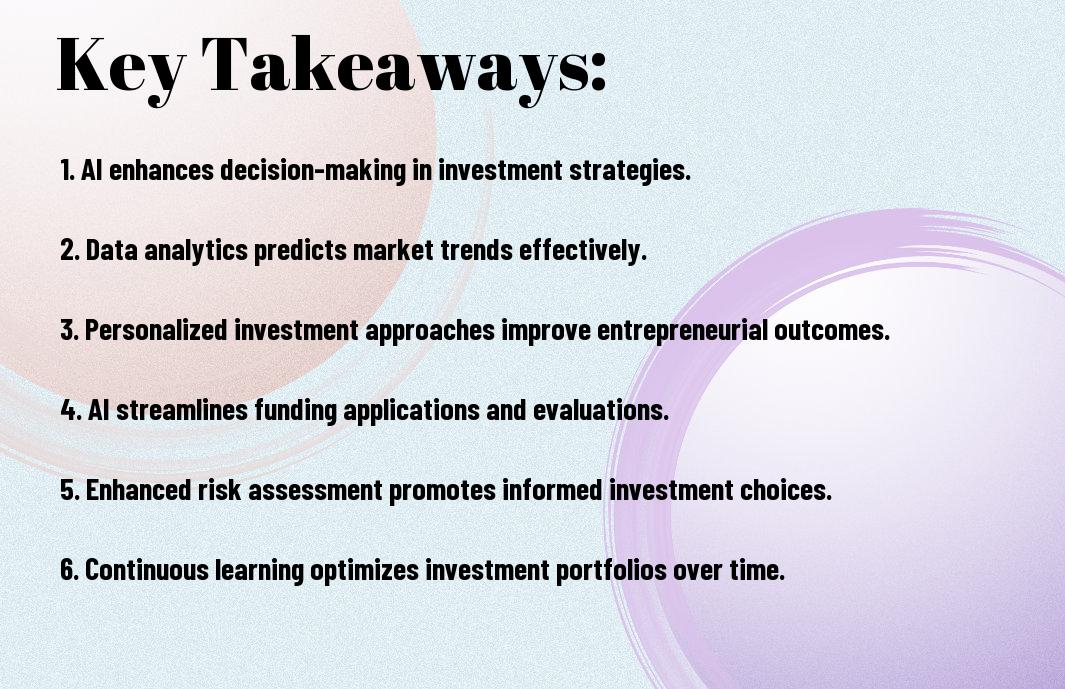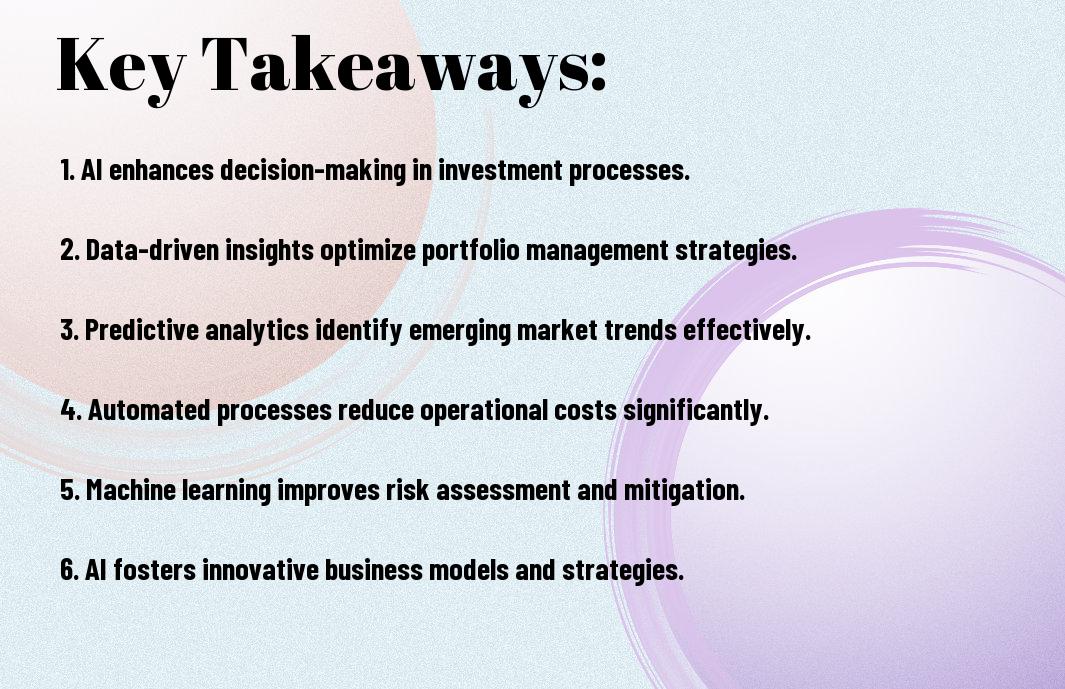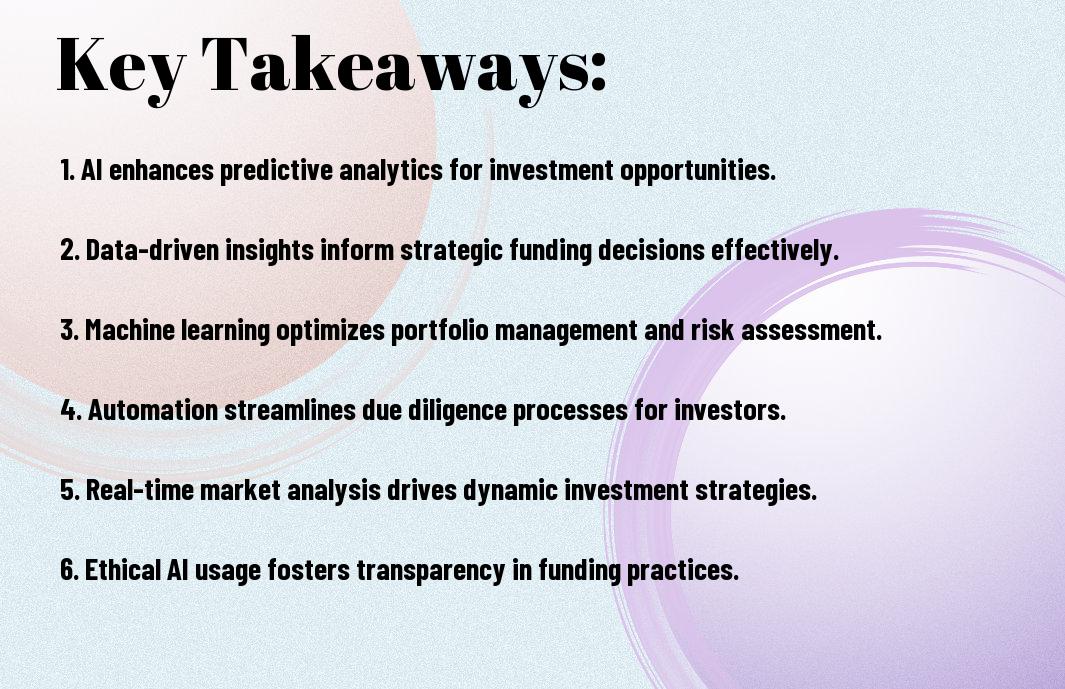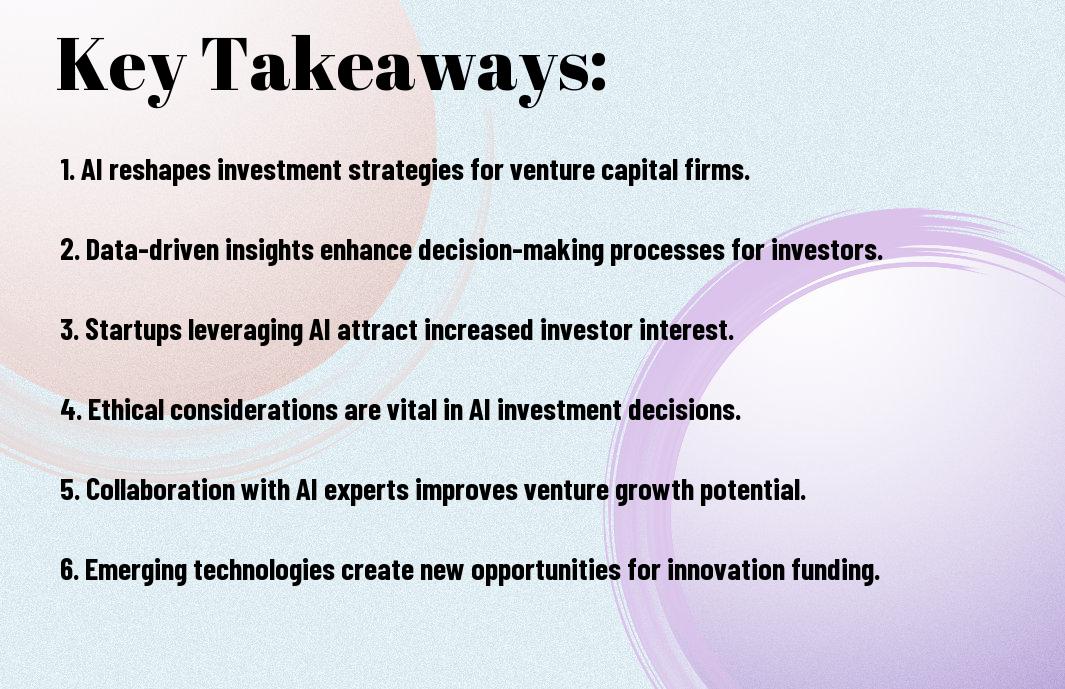As you navigate the complex world of entrepreneurship, you’re likely aware that making informed investment decisions is key to your success. Your ability to analyze data and make strategic choices can significantly impact your wealth. With the advent of Artificial Intelligence (AI), you now have access to advanced tools that can help you optimize your investment strategies, providing you with a competitive edge in the market and enabling you to make more accurate predictions about your business’s future performance.
Key Takeaways:
- AI-driven investment strategies are transforming the way entrepreneurs approach wealth creation, enabling them to make more informed decisions and optimize their portfolios with predictive analytics and machine learning algorithms.
- The integration of AI in investment processes allows for real-time data analysis, providing entrepreneurs with a competitive edge in identifying emerging trends and opportunities, and enabling them to adapt quickly to changing market conditions.
- By leveraging AI-powered tools and platforms, entrepreneurs can streamline their investment operations, reduce risk, and unlock new avenues for growth, ultimately redefining the landscape of investment in entrepreneurship and creating new pathways to wealth creation.
The AI Revolution in Investment Landscapes
For investors, the integration of artificial intelligence (AI) is transforming the way you approach wealth creation. You can now leverage AI-powered tools to make data-driven decisions, maximizing your returns and minimizing risks. This shift is redefining the investment landscape, enabling you to stay ahead of the curve.
Traditional Investment Models vs AI-Powered Decisions
To navigate the complexities of investment, you need to understand the differences between traditional models and AI-driven approaches. You will notice that AI-powered decisions offer more accuracy and speed, allowing you to respond quickly to market changes and make informed choices.
Machine Learning Algorithms in Market Analysis
On the forefront of this revolution are machine learning algorithms, which enable you to analyze vast amounts of market data and identify patterns that inform your investment strategies. You can use these algorithms to predict market trends and make decisions that drive your wealth creation goals.
Consequently, as you probe deeper into machine learning algorithms, you will discover their potential to analyze complex market data, identify trends, and provide insights that inform your investment decisions. You can apply these algorithms to various asset classes, from stocks to real estate, and optimize your portfolio to achieve your financial objectives, giving you a competitive edge in the investment landscape.

Predictive Analytics and Investment Opportunities
It is no secret that predictive analytics is revolutionizing the way you approach investment opportunities, and you can learn more about The Impact of AI in Wealth Management to make informed decisions. By leveraging AI, you can uncover hidden patterns and trends, giving you a competitive edge in the market.
Pattern Recognition in Startup Success
Against the backdrop of a rapidly changing entrepreneurial landscape, you can utilize AI-powered tools to identify successful startup patterns, allowing you to make more informed investment decisions and maximize your returns.
Risk Assessment Through Data Mining
Beside the potential for high returns, you must also consider the risks involved in investing in startups, and data mining can help you assess these risks by analyzing large datasets and identifying potential pitfalls.
Predictive analytics plays a significant role in risk assessment, enabling you to forecast potential outcomes and adjust your investment strategy accordingly, thereby protecting your assets and ensuring your financial security as you navigate the complex world of entrepreneurship and investment.
Digital Transformation of Venture Capital
To stay ahead in the investment game, you need to understand how AI is changing the landscape of venture capital, as seen in AI and the Future of Wealth Management: How AI is Redefining Investment Advice and Client Relationships, which is revolutionizing your approach to investment.
Automated Deal Flow Management
Deals are now being managed more efficiently with AI, allowing you to focus on high-potential investments and streamlining your workflow, making your investment process more effective.
AI-Driven Due Diligence Processes
Around the clock, AI-driven due diligence processes are analyzing vast amounts of data, helping you make informed decisions about your investments and minimizing your risk exposure.
Due to the advanced capabilities of AI, you can now conduct thorough due diligence processes, analyzing complex data sets and identifying potential issues before they become major problems, giving you a competitive edge in the investment landscape and allowing you to make smarter, data-driven decisions about your investments.
Entrepreneurial Success Metrics
Once again, you find yourself at the forefront of innovation, navigating the complex world of entrepreneurship, where data-driven decisions are key to your success. You need to understand the metrics that define your entrepreneurial journey, and how AI is transforming the way you approach investment and growth.
Data Points That Matter
Prior to making informed decisions, you must identify the data points that have a significant impact on your business, such as revenue growth, customer acquisition, and market trends, which will help you refine your investment strategy and drive your business forward.
Performance Indicators in the Digital Age
Indicative of a successful entrepreneurial venture, your performance indicators must be aligned with the digital landscape, incorporating metrics such as website traffic, social media engagement, and online customer reviews, to gauge your business’s overall health and make data-driven decisions.
Success in the digital age is contingent upon your ability to leverage these performance indicators to inform your investment decisions, and AI can help you analyze and interpret this data to optimize your business strategy, allowing you to make more informed decisions and drive your business towards long-term growth and profitability, ultimately leading to your entrepreneurial success.

The Human-AI Investment Partnership
Keep in mind that AI is not replacing human investors, but rather augmenting their capabilities. You can leverage AI to analyze vast amounts of data, identify patterns, and make predictions, freeing up your time to focus on high-level decision-making.
Balancing Algorithmic Insights with Human Judgment
By combining AI-driven insights with your own expertise, you can make more informed investment decisions. You will be able to identify potential biases in AI recommendations and adjust them according to your own risk tolerance and investment goals.
Building Trust in AI Investment Tools
By utilizing transparent and explainable AI models, you can gain a deeper understanding of how investment recommendations are generated, allowing you to trust the decisions made by these tools.
Judgment is key when it comes to building trust in AI investment tools. As you use these tools, you will begin to understand their strengths and limitations, and be able to adjust your investment strategy accordingly. You will be able to evaluate the performance of AI-driven investments and make adjustments to optimize your portfolio, ultimately leading to more effective investment decisions.
Future Investment Trends
Now, as you navigate the evolving landscape of entrepreneurship, you’ll notice that data-driven wealth is becoming increasingly prominent, with AI playing a key role in redefining investment strategies, enabling you to make more informed decisions.
Emerging Technologies in Investment Analysis
Besides the current tools, you’ll find that emerging technologies like machine learning and natural language processing are being integrated into investment analysis, allowing you to analyze vast amounts of data and identify trends that may not be immediately apparent, giving you a competitive edge.
Global Market Integration Through AI
About to revolutionize the way you invest, global market integration through AI is enabling you to access a broader range of investment opportunities, connecting you with investors and markets worldwide, and facilitating more efficient transactions.
Technologies such as blockchain and cloud computing are supporting this integration, providing you with secure, transparent, and scalable platforms to manage your investments, and allowing you to respond quickly to changing market conditions, thereby maximizing your returns and minimizing your risks, as you leverage the power of AI to drive your investment decisions.
Summing up
As a reminder, you now have insight into how AI is revolutionizing investment in entrepreneurship through data-driven wealth. You can leverage this knowledge to make informed decisions, maximizing your investment potential. Your understanding of AI’s role in shaping the future of entrepreneurship will help you navigate the evolving landscape and capitalize on emerging opportunities, ultimately transforming your approach to investment and wealth creation.
FAQ
Q: What is Data-Driven Wealth and how is it changing the investment landscape in entrepreneurship?
A: Data-Driven Wealth refers to the use of advanced data analytics and artificial intelligence (AI) to make informed investment decisions in entrepreneurial ventures. This approach is revolutionizing the investment landscape by providing a more accurate and efficient way to identify high-potential startups and optimize investment portfolios. With the help of AI, investors can analyze vast amounts of data, including market trends, financial performance, and industry benchmarks, to make data-driven decisions that minimize risk and maximize returns.
Q: How is AI being used in Data-Driven Wealth to support entrepreneurial investment decisions?
A: AI is being used in several ways to support Data-Driven Wealth, including predictive modeling, risk assessment, and portfolio optimization. For example, AI algorithms can analyze historical data and market trends to predict the likelihood of a startup’s success, allowing investors to make more informed decisions. Additionally, AI can help identify potential risks and opportunities, enabling investors to adjust their portfolios accordingly. Furthermore, AI can optimize investment portfolios by identifying the most promising startups and allocating resources effectively.
Q: What are the benefits of using Data-Driven Wealth in entrepreneurial investment, and how does it compare to traditional investment methods?
A: The benefits of using Data-Driven Wealth in entrepreneurial investment include increased accuracy, efficiency, and transparency. By leveraging AI and data analytics, investors can make more informed decisions, reduce the risk of human bias, and optimize their investment portfolios. Compared to traditional investment methods, Data-Driven Wealth offers a more systematic and data-driven approach, which can lead to higher returns and lower risk. Additionally, Data-Driven Wealth can help investors identify emerging trends and opportunities, allowing them to stay ahead of the competition.
Q: How can entrepreneurs prepare their startups for Data-Driven Wealth investment, and what are the key factors that investors look for in a data-driven investment opportunity?
A: To prepare their startups for Data-Driven Wealth investment, entrepreneurs should focus on collecting and analyzing relevant data, developing a robust financial model, and demonstrating a clear understanding of their market and industry. Investors look for startups with a strong data-driven approach, a clear value proposition, and a scalable business model. Additionally, investors consider factors such as market size, competitive landscape, and team experience when evaluating investment opportunities. By having a solid data-driven foundation, entrepreneurs can increase their chances of securing investment and achieving success.
Q: What is the future of Data-Driven Wealth in entrepreneurial investment, and how will it continue to evolve and shape the investment landscape?
A: The future of Data-Driven Wealth in entrepreneurial investment is promising, with AI and data analytics continuing to play a central role in investment decisions. As technology advances, we can expect to see even more sophisticated AI algorithms and data analytics tools being developed to support Data-Driven Wealth. Additionally, the increasing availability of data and the growing adoption of AI will lead to more efficient and effective investment processes. As a result, Data-Driven Wealth is likely to become the norm in entrepreneurial investment, enabling investors to make more informed decisions and driving innovation and growth in the startup ecosystem.













